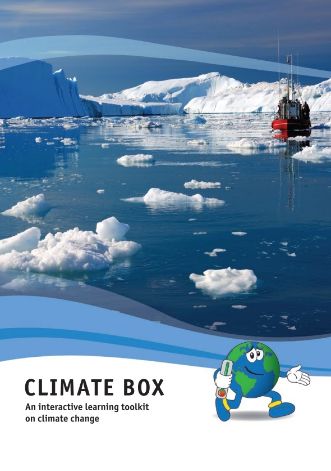The Climate Box textbook is part of an interactive learning toolkit on climate change aimed at the primary and secondary school students and teachers specializing in natural sciences and environment studies. The toolkit was prepared by the United Nations Development Programme (UNDP) with financial support from the Global Environment Facility, the Government of the Russian Federation and the Coca-Cola Company. Climate Box continues a series of environmental toolkits for students, which also includes the Black Sea Box and Baikal’s Little Treasure Chest.
About the Climate Box project
Climate change has been recognized by the United Nations as one of the most important global issues today. The problem is global because the effects of climate change are felt in all countries and regions of the world and because each one of us, in varying degrees, bears responsibility for the changes, which are occurring on our planet. We are the ultimate consumers of goods and services, which require resources and energy, i.e. fossil fuels (oil, coal and natural gas), for their production. Production and consumption of fossil fuels cause emission of the so-called greenhouse gases into the atmosphere, which increases the greenhouse effect and global air temperatures. This is the carbon footprint that we leave on Earth.
To reduce the burden on the environment and reduce our carbon footprint, we need relevant knowledge. It is important that such knowledge and habits are instilled from an early age, so that everyone understands by the time he or she leaves school how important it is to take good care of the natural environment and resources.
With this aim in mind, the United Nations Development Programme (UNDP), with the support of the Global Environment Facility (GEF), the Government of the Russian Federation and the Coca-Cola Company, has developed the Climate Box: an interactive learning toolkit on climate change for students.
The Climate Box consists of:
- an illustrated textbook for students with educational materials and a variety of questions
- and tasks for individuals and groups, as well as guidelines for teachers on use of the toolkit
in lessons for students in different age groups; - the Climate Quiz – a set of game cards;
- a wall map illustrating the possible effects of climate change on nature and mankind in
various parts of the world by the end of the 21st century; - a poster with tips on how to reduce your carbon footprint;
- a disk with all of the toolkit materials.
The main objective of the Climate Box is to provide students with important information on issues related to global climate change in an interesting, attractive and entertaining way, as well as recommendations to teachers on use of the toolkit in the school curriculum.
A big team of authors was working on the Climate Box, including the leading experts in climatology, geography, biology and economics, as well as professional writers of books for children. Experienced school teachers made an invaluable contribution to the project by helping to develop guidelines on classroom use of the toolkit by teachers.
It is important that the Climate Box was designed specifically for school students. The textbook is like an illustrated encyclopedia about climate, describing important and sometimes difficult issues in an entertaining way. Readers learn how the Earth’s climate has changed from the earliest geological epochs, what climate changes are happening now, how these changes affect nature and humanity, whether we can adapt to the inevitable impacts, how to prevent the most dangerous consequences of global warming, and what is already being done in different regions of the world. A separate section of the book explains the reader how to reduce personal carbon footprint.
The textbook and other materials in the Climate Box have been designed in a way that lets young readers use them independently. Some topics focus on younger kids, and others – on secondary school students. Some readers will find the whole book of interest while others will be attracted by specific intriguing facts, illustrations or ideas for experiments. Everyone will find something new and interesting for him or herself in the Climate Box.
Success of the piloting phase of the Climate Box, appreciation of climate change experts, teaches and school children brought up an ambition to make it a truly international educational kit uniting children and teachers across the borders.
By 2017, UNDP scaled-up implementation of the Climate Box project across eight countries in Eastern Europe, Caucasus and Central Asia with an ambition of further replication. Digital versions of the toolkit are available to kids in English and in Russian languages on www.climate-box.com website and on mobile applications.
This revised 2018 English version of the Climate Box toolkit contains the most up-to-date information and includes feedback and recommendations received from teachers and experts in the participating countries.
We hope that the Climate Box will be an intriguing and useful source of information on climate change for schoolchildren and will help them learn how to protect the natural world.
Preface for Climate Box 
2030, 2050, 2100 – these are the years that are most often mentioned when we talk about man-made climate change, its impacts, and the need to adapt to the transformations that will happen in the future. Such times appear far away for most people – but not for you, for these waypoints on the time axis will be important for the new generation. What will I work in 2030? Where will I live in 2050? How will my children find a happy life in 2100? These questions are fundamental for today’s students, from school to university.
Our generation is used to seek answers to such future-oriented questions by looking at ourselves, by getting the best education, by working hard, and by being creative and inventive. However, man-made climate change will change not only the living conditions on Earth – our only home – but will also more and more influence the options for our own life, the well-being of our families, and that of our neighbors close, far and wide. Climate change will become the most determinant factor of our living conditions.
This is why the Climate Box is timely. We need to know what determines our future, we need to understand how our decisions today impact not only ourselves over our own life horizon but how they will influence in multiple and complicated ways our children and grandchildren. The scientific knowledge on the human influence on Earth, on its climate and on all resources must be taught at the earliest stage. The sensitivity for these issues must be nurtured as early as possible. Instruction comes in many forms. The Climate Box offers a fresh and dynamic entry to this complex topic. By wrapping the most up-to-date scientific results into simple graphics, cartoons, and stories, the students are able to easily digest the knowledge through multiple channels. The Tasks in the Climate Box help to recall, evaluate and fix the understanding.
Globalization has brought us many benefits, but we are ill equipped to live, work and function in a globalized world. Our brain has trained for millennia to react and adapt to the changes that happen in our immediate environment. This has been essential for our survival. Evidently, our personal sensors do not go beyond what we see and hear. However, today our actions, foremost the consumption of energy from fossil fuels, the consumption of land reserves through deforestation and many other activities, have global consequences which threaten the survival of all of us.
Our survival kit, therefore, is in dire need of an upgrade. This upgrade comes from the science that provides us with the understanding of the changing climate and with the ability to estimate the possible futures depending on our choices today. It is in our hands today whether we will live in a world that is different from today, a warmer world with a changed climate, but still a home to which most people on Earth are able to adapt to, and to comfortably live in. Or whether, as a consequence of unchecked climate change, we will experience a fundamentally different world, much warmer than anything that humans and ecosystems can cope with, with sea level higher by at least 1 meter, vast expanses of coastal land areas submerged and unlivable, glaciers wasted and the Arctic environment irreversibly altered, extreme weather events that harm the most vulnerable people, and many ecosystems that have ceased to provide their services. This other world is projected to result from “business-as-usual”, a quite inappropriate and treacherous term, as it innocuously suggests that in 2050 or 2100, business as we know it today will still be carried out “as usual”. The informed citizen knows already today, that this will not be the case in this scenario.
By knowing about these life-threatening consequences through science and instruction, by increased sensitivity and awareness through learning material such as the Climate Box, available at all levels of teaching, I hope that we prepare the next generation not to lose as much time as we did, and to take the right decisions.
Thomas Stocker
Co-Chair IPCC Working Group I 2008–2015
Professor of Physics
University of Bern, Switzerland
The authors:
Vladimir Berdin (lead author, Sections 1.1.-1.4, 2.6, 2.8 and 3.5)
Ekaterina Gracheva (Sections 3.1, 3.2 and 3.4)
Yulia Dobrolyubova (overall editing, Sections 2.7, 2.9 and 2.10)
D.Sc. Dmitry Zamolodchikov (Section 2.3)
D.Sc. Pavel Konstantinov (Sections 1.1, 2.1, 2.4, 2.5, 2.9)
D.Sc. Natalia Ryzhova (Section 2.2)
D.Sc. Elena Smirnova (overall editing, Sections 3.2, 3.3, 3.4)
Pedagogical reviewers:
D.Sc. Elena Smirnova
Lyubov Kolotilina
Project сoordinator:
Yulia Dobrolyubova
Language editors:
Elena Ermakova
Ben William Hooson
Technical review:
Terence John Carrington
Design and layout:
Anna Alekperova, RA ILF LLC
Printed by
RA ILF LLC, Office 1, Building 1, 10 Bolshsoi Kondratyevsky Lane, Moscow, 123056
Project managers:
Natalia Olofinskaya
D.Sc.Sergey Tambiev
Antonina Khovanskaya
Elena Surovikina
Acknowledgements:
Project team thanks all the advisors and scientific consultants who helped to prepare the Climate Box interactive learning toolkit, particularly:
Alexey Kokorin (WWF) for valuable advice in preparation of the sections ‘Climate сhange’ and ‘How climate change affects the Arctic region‘;
Yulia Kalinicheva (WWF) аssistance in preparing the wall map and poster;
Alexey Soldatov (BSH Home Appliances LLC) and Olga Pegova (WWF) for their assistance in preparation of materials on the theme ‘Energy efficiency and energy saving’;
The following teachers at School № 9 Pereslavl-Zalessky (Yaroslavl region, Russia) who helped in work on
the Climate Box toolkit: Vera Zabavina, Svetlana Rudneva, Tatiana Gordeyeva, Svetlana Tokar, Galina Vorozhtsova, Olga Volodina, Tatiana Kukushkin, Galina Vasikova, Lyudmila Bubnova.
Climate Box: An interactive learning toolkit on climate change. / V. Berdin, E. Gracheva, Y. Dobrolyubova et al. – United Nations Development Programme, 2018. – 254, [2].
The Climate Box textbook is part of an interactive learning toolkit on climate change aimed at the primary and secondary school students and teachers specializing in natural sciences and environment studies. The toolkit was prepared by the United Nations Development Programme (UNDP) with financial support from the Global Environment Facility, the Government of the Russian Federation and the Coca-Cola Company. Climate Box continues a series of environmental toolkits for students, which also includes the Black Sea Box and Baikal’s Little Treasure Chest.
UDC 373.3 (5): 551,583
BBK: 74.26:26.237
K49
ISBN978-5-9902971-2-8

